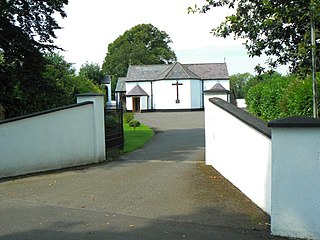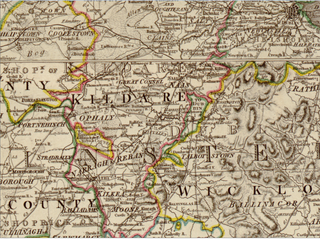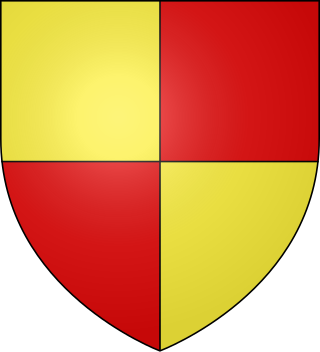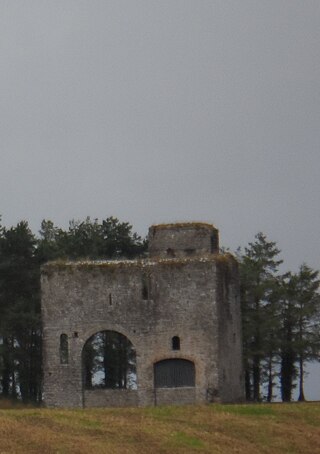Alexander Plunket was an Irish statesman and judge of the fifteenth century.
James Butler, 4th Earl of Ormond was the son of James Butler, 3rd Earl of Ormond. He was called 'The White Earl', and was esteemed for his learning. He was the patron of the Irish literary work, 'The Book of the White Earl'. His career was marked by his long and bitter feud with the Talbot family.

Rathcoffey is a village in County Kildare, Ireland, around 30 km west of Dublin city centre. It had a population of 271 as of 2016 census. The village church, Rathcoffey Church, is part of the Clane & Rathcoffey Parish, and was built in 1710. Rathcoffey National School, a co-educational Catholic primary school, is the only educational institution in the village. Rathcoffey GAA is a Gaelic Athletic Association (GAA) club based in Rathcoffey. The club was founded in February 1888. Teams representing the club play hurling, camogie and Gaelic football.
Sir Maurice Eustace was an Irish landowner, politician, barrister and judge of the seventeenth century who spent the last years of his career as Lord Chancellor of Ireland. This was an office for which he felt himself to be entirely unfit, and in which he was universally agreed to be a failure.

Thomas Chase, or Chace was a 15th-century judge, scholar and cleric who was Chancellor of the University of Oxford, and subsequently held the office of Lord Chancellor of Ireland.

The High Sheriff of Kildare was the British Crown's judicial representative in County Kildare, Ireland from the 16th century until 1922, when the office was abolished in the new Free State and replaced by the office of Kildare County Sheriff. The High Sheriff had judicial, electoral, ceremonial and administrative functions and executed High Court Writs. In 1908, an Order in Council made the Lord Lieutenant the Sovereign's prime representative in a county and reduced the High Sheriff's precedence. However, the sheriff retained his responsibilities for the preservation of law and order in the county. The usual procedure for appointing the sheriff from 1660 onwards was that three persons were nominated at the beginning of each year from the county and the Lord Lieutenant then appointed his choice as High Sheriff for the remainder of the year. Often the other nominees were appointed as under-sheriffs. Sometimes a sheriff did not serve his full term due to death or another event, and another sheriff was then appointed for the remainder of the year. The dates given in this article are the dates of appointment.
Thomas Le Boteller, or Thomas Butler, nicknamed Thomas Bacach i.e. Thomas the Lame, was the illegitimate son of the 3rd Earl of Ormond, and a leading political figure in early fifteenth-century Ireland. He held the offices of Lord Chancellor of Ireland, Lord Deputy of Ireland and Prior of Kilmainham. In his own lifetime, he was a highly unpopular statesman, who was accused by his numerous enemies of treason. He is now chiefly remembered as a professional soldier, who was present at the Siege of Rouen in 1418–19. He had previously fought in the sanguinary conflict known as the Battle of Bloody Bank near Dublin in 1402.

Sir Richard FitzEustace (c.1380–1445) was an Irish statesman who twice held the office of Lord Chancellor of Ireland.
Sir Robert FitzEustace (c.1420–1486) was an Irish landowner and politician of the fifteenth century.
Richard Talbot was an English-born statesman and cleric in fifteenth-century Ireland. He was a younger brother of John Talbot, 1st Earl of Shrewsbury. He held the offices of Archbishop of Dublin and Lord Chancellor of Ireland. He was one of the leading political figures in Ireland for more than thirty years, but his career was marked by controversy and frequent conflicts with other statesmen. In particular, the Talbot brothers' quarrel with the powerful Earl of Ormonde was the main cause of the Butler–Talbot feud, which dominated Irish politics for decades, and seriously weakened the authority of the English Crown in Ireland.

Sir John Wogan or John de Wogan, styled lord of Picton was a Cambro-Norman judge who served as Justiciar of Ireland from 1295 to 1313.
Sir Robert Dowdall was an Irish judge who held the office of Chief Justice of the Irish Common Pleas for more than forty years. He is mainly remembered today for the murderous assault on him by Sir James Keating, the Prior of Kilmainham, in 1462.
Richard Delahide was an Irish judge of the sixteenth century, who held the offices of Chief Justice of the Irish Common Pleas and Chief Baron of the Irish Exchequer. His career was seriously damaged by the Rebellion of Silken Thomas, in which several members of his family played a leading part, and he was fortunate to escape permanent disgrace.
William Chevir was an Irish politician and judge, whose career was marked by accusations of oppression and corruption.
Giles Thorndon was a senior official of the English Crown in the fifteenth century, who was noted for his long and loyal service to the House of Lancaster and for his troubled and unsuccessful career as Lord Treasurer of Ireland.
Christopher Preston, 2nd Baron Gormanston was an Anglo-Irish peer and statesman. He was accused of treason and imprisoned in 1418-19, but was soon released and restored to Royal favour.
Robert Dyke, Dyck or Dyche was an English-born cleric and judge who held high office in fifteenth-century Ireland. He was appointed to the offices of Archdeacon of Dublin, Chancellor of the Exchequer of Ireland, Lord High Treasurer of Ireland, and Master of the Rolls in Ireland, as well as holding several Church livings.
Edward Somerton, or Somertoune was an Irish barrister and judge who held the offices of Serjeant-at-law (Ireland) and judge of the Court of King's Bench (Ireland) and the Court of Common Pleas (Ireland). He was born in Ireland, possibly in Waterford, although he lived much of his life in Dublin. By 1426 he was a clerk in the Court of Chancery (Ireland), and was paid 26 shillings for his labours in preparing writs and enrolment of indentures, i.e. agreements between the Lord Lieutenant of Ireland and former Irish enemies of the Crown In 1427 he is recorded in London studying law at Lincoln's Inn. He returned to Ireland and was again in the Crown service by 1435, when he was ordered to convey lands at Beaulieu, County Louth to Robert Chambre, one of the Barons of the Court of Exchequer (Ireland). He was appointed King's Serjeant for life in 1437; he also acted as counsel for the city of Waterford, a position subsequently held by another future judge, John Gough.

Rathcoffey Castle is a 15th-century castle in Rathcoffey, County Kildare, Ireland. It is a National Monument.
Thomas Shortalls, or Shorthals (c.1370–1445) was an Irish municipal official and judge of the fifteenth century.






